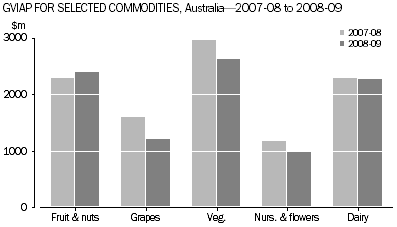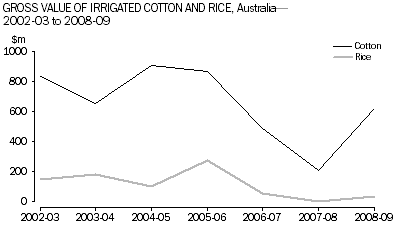|
BACKGROUND
Gross Value of Irrigated Agricultural Production (GVIAP) estimates have been a core component of the ABS Water Account Australia (cat. no. 4610.0) which is produced every four years. Growing demand from policy-makers and other users has led to an increasing pressure on the ABS to produce more accurate and frequent estimates of GVIAP at a sub-state geographic level. This product presents the ABS response to these information needs.
GVIAP refers to the gross value of agricultural commodities that are produced with the assistance of irrigation. The gross value of commodities produced is the value placed on recorded production at the wholesale prices realised in the marketplace. Note that this definition of GVIAP does not refer to the value that irrigation adds to production, or the "net effect" that irrigation has on production - rather, it simply describes the gross value of agricultural commodities produced with the assistance of irrigation. GVIAP is not a measure of productivity.
For this reason, extreme care must be taken when attempting to use GVIAP figures to compare different commodities - that is, the gross value of irrigated production should not be used as a proxy for determining the highest value water uses. Rather, it is a more effective tool for measuring changes over time or comparing regional differences in irrigated agricultural production.
Note that the estimates of GVIAP and GVAP (Gross Value of Agricultural Production) presented in this publication are given in current prices; that is, estimates are valued at the commodity prices of the period to which the observation relates. For example, estimates for the 2004–05 reference period are given in terms of prices in the 2004–05 period and estimates for the 2008–09 reference period are given in terms of 2008–09 prices. This must be taken into consideration when considering movements over time. |
In the first issue of this product, released in May 2009, tables relating to the reference period 2000–01 to 2006–07 were presented for Australia, States and Territories and the Murray-Darling Basin.
The second issue, released in July 2010, built on the time series with the addition of 2007–08 data for Australia, States and Territories and the Murray-Darling Basin, as well as Natural Resource Management (NRM) region level data for 2005–06, 2006–07 and 2007–08.
This third issue continues to build on the time series with the addition of 2008–09 data for Australia, the States and Territories, the Murray-Darling Basin, and Natural Resource Management (NRM) regions for all of Australia.
The ABS plans to release GVIAP estimates on an annual basis.
ABS welcomes comments on these estimates. Please contact Steven May on 02 6252 5593 or email at steven.may@abs.gov.au.
SUMMARY OF FINDINGS
In 2008–09, irrigated agricultural land comprised less than 0.5% of all agricultural land in Australia. The gross value of production from irrigation was $11,953 million, which represented 28.6% of the total gross value of agricultural production. This figure was only slightly down from 2007–08, when GVIAP was $12,311 million and represented 28.5% of the total gross value of agricultural production.
In general, there has been an increasing trend in GVIAP since 2000–01 when it was $9,669 million, although 2008–09 was the second successive year in which GVIAP decreased from the previous year's total.

Despite the decrease in GVIAP in 2008–09 there was a slight increase in the volume of water used for irrigation. Australia's irrigated agricultural water use in 2008–09 increased 3% to 6,501 gigalitres, following two successive years of large decreases (down 29% from 2005–06 to 2006–07 and 18% from 2006–07 to 2007–08).

In 2008–09, vegetables (for human consumption and seed) contributed the highest value to total irrigated production of $2,625 million, followed by fruit and nuts ($2,390 million) and dairy production ($2,274 million). These three commodity groups accounted for 61% of total GVIAP.

There are some commodities for which the value of irrigated production contributes significantly to the total value of agricultural production. The entire value of rice production in Australia ($7 million in 2007–08, increasing to $34 million in 2008–09) is produced under irrigation. The irrigated value of production from cotton, grapes, fruit and nuts, vegetables and nurseries, cut flowers and cultivated turf in 2007–08 accounted for 75% or more of total production for each of those products. Cotton followed the same trend as rice in 2008–09 with a 198% increase in irrigated agricultural production.

The States which contributed the most to the value of irrigated production during 2008–09 were Victoria, $3,266 million (27% of Australia's total GVIAP), and Queensland $3,255 million (also 27% of the Australian total). The GVIAP for both South Australia and Victoria decreased by 12% from 2007–08 to 2008–09, as opposed to the GVIAP for the Australia Capital Territory and the Northern Territory, which increased by 22% and 13% respectively over the same period.
The NRM producing the most GVIAP in 2008–09 was Goulburn-Broken, in the MDB in central Victoria. The GVIAP for this region was $810 million, a decrease of 22% from 2007–08. The NRM with the next highest GVIAP in 2008–09 was South Australia Murray-Darling Basin ($756 million, down 16% from 2007–08), followed by Burnett Mary in Queensland ($638 million, up 11.4% from 2007–08).
The NRM's with the highest proportion of total agricultural production that was irrigated (i.e. GVIAP as a proportion of GVAP) in 2008–09 were Lower Murray Darling in New South Wales (69%), North West Tasmania (65%), Goulburn Broken in Victoria (64%) and Adelaide and Mount Lofty Ranges (62%).
From 2007–08 to 2008–09, the Wets Tropics NRM in Queensland was the NRM region with the greatest increase in GVIAP ($359 million to $503 million). The main reason for this was an increase in the GVIAP of fruit and nuts in this region (from $247 million to $363 million). Border Rivers-Gwydir in New South Wales was the NRM region with the second highest increase, from $122 million in 2007–08 to $226 million in 2008–09, mainly due to an increase in the GVIAP of cotton (from $45 million to $159 million).
Statistics for the Murray-Darling Basin (MDB) relating to irrigation are available for 2000–01, 2005–06, 2006–07, 2007–08 and 2008–09. In 2008–09 the MDB had irrigated production to the value of $4,349 million, or 36% of Australia’s total value of irrigated production. In contrast, the value of irrigated production in the MDB in 2000–01 was $5,085 million, or 53% of the total value of irrigated production for the nation at that time.
Irrigated production in the MDB accounted for 30% of the total value of all agricultural commodities produced in the Basin in 2008–09 (down from 33% in 2007–08).
The commodities that contributed most to the value of irrigated production during 2008–09 in the MDB were fruit and nuts ($1,033 million or 24%), dairy production ($791 million or 18%) and grapes ($598 million or 14%).
|
 Print Page
Print Page
 Print All
Print All
 Quality Declaration
Quality Declaration